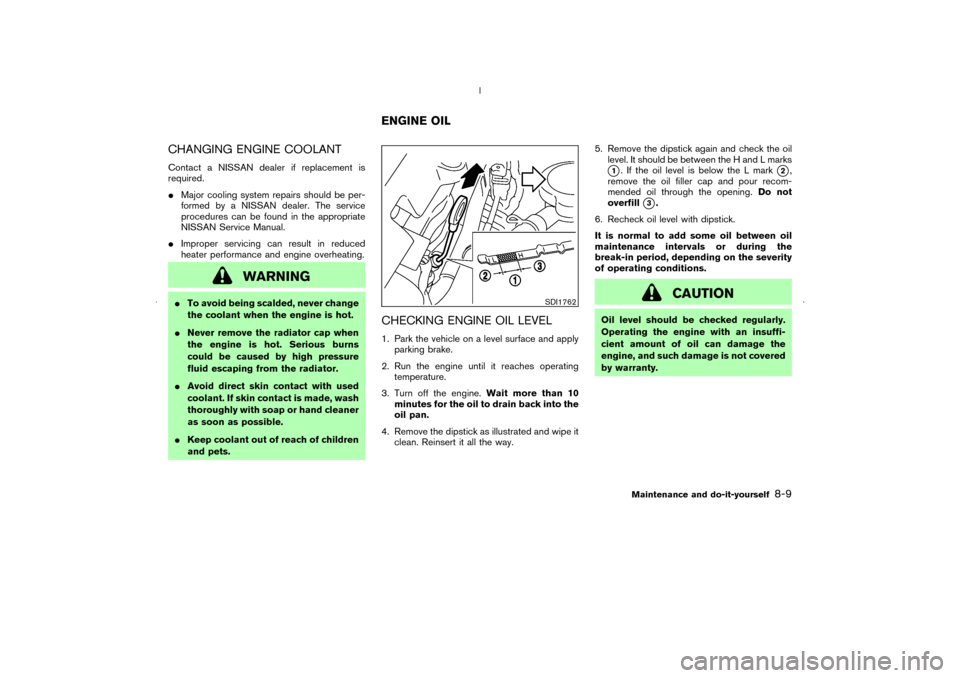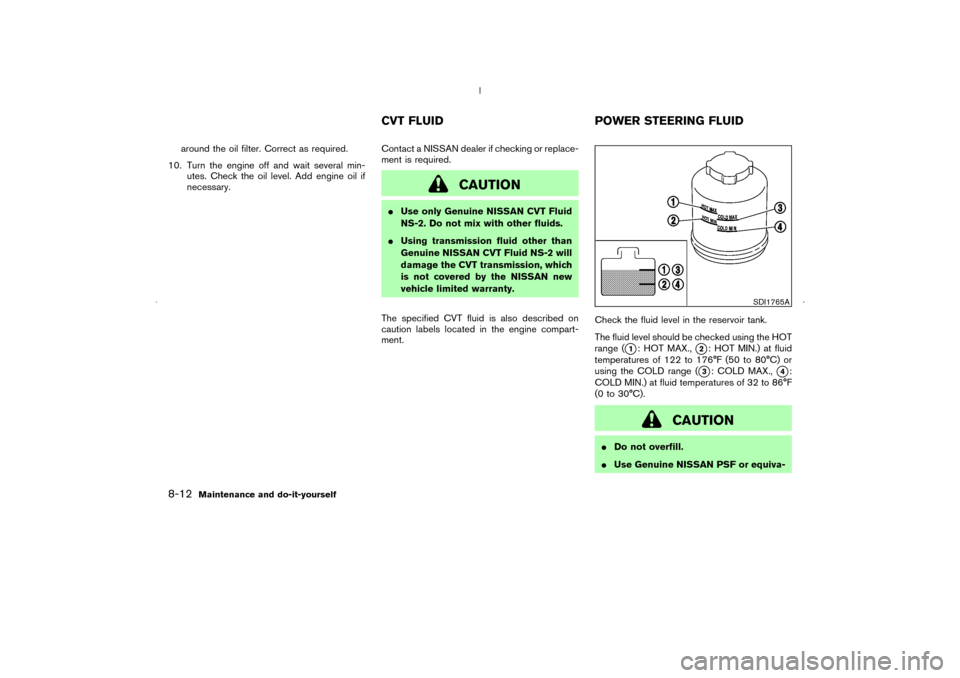Page 263 of 341

Windshield wiper and washer*:Check that
the wipers and washer operate properly and that
the wipers do not streak.Under the hood and the vehicleThe maintenance items listed here should be
checked periodically (for example, each time you
check the engine oil or refuel).
Battery*:Check the fluid level in each cell. It
should be between the MAX and MIN lines.
Vehicles operated in high temperatures or under
severe conditions require frequent checks of the
battery fluid level.
Brake fluid level*:Make sure that the brake
fluid level is between the MAX and MIN lines on
the reservoir.
Engine coolant level*:Check the coolant level
when the engine is cold.
Engine drive belts*:Make sure that no belt is
frayed, worn, cracked or oily.
Engine oil level*:Check the level on the
dipstick after parking the vehicle on a level spot
and turning off the engine.
Exhaust system:Make sure there are no loose
supports, cracks or holes. If the sound of the
exhaust seems unusual or there is a smell of
exhaust fumes, immediately locate the trouble
and correct it. (See “Precautions when startingand driving” in the “5. Starting and driving”
section for exhaust gas (carbon monoxide).)
Fluid leaks:Check under the vehicle for fuel,
oil, water or other fluid leaks after the vehicle has
been parked for a while. Water dripping from the
air conditioner after use is normal. If you should
notice any leaks or if gasoline fumes are evident,
check for the cause and have it corrected imme-
diately.
Power steering fluid level* and lines:Check
the level in the reservoir tank with the engine off.
Check the lines for proper attachment, leaks,
cracks, etc.
Radiator and hoses:Check the front of the
radiator and clean off any dirt, insects, leaves,
etc., that may have accumulated. Make sure the
hoses have no cracks, deformation, deterioration
or loose connections.
Underbody:The underbody is frequently ex-
posed to corrosive substances such as those
used on icy roads or to control dust. It is very
important to remove these substances, other-
wise rust will form on the floorpan, frame, fuel
lines and around the exhaust system. At the end
of winter, the underbody should be thoroughly
flushed with plain water, being careful to clean
those areas where mud and dirt may accumu-
late. For additional information, see “Cleaningexterior” in the “7. Appearance and care” sec-
tion.
Windshield washer fluid*:Check that there is
adequate fluid in the tank.8-4
Maintenance and do-it-yourself
�
05.8.26/Z50-D/V5.0
�
Page 266 of 341
1. Power steering fluid reservoir
2. Engine oil filler cap
3. Brake fluid reservoir
4. Air cleaner
5. Windshield washer fluid reservoir
6. Engine coolant reservoir
7. Drive belts
8. Radiator filler cap
9. Engine oil dipstick
10. Fuse/fusible link holder
11. Battery
SDI1760
ENGINE COMPARTMENT CHECK
LOCATIONS
Maintenance and do-it-yourself
8-7
�
05.8.26/Z50-D/V5.0
�
Page 268 of 341

CHANGING ENGINE COOLANTContact a NISSAN dealer if replacement is
required.
�Major cooling system repairs should be per-
formed by a NISSAN dealer. The service
procedures can be found in the appropriate
NISSAN Service Manual.
�Improper servicing can result in reduced
heater performance and engine overheating.
WARNING
�To avoid being scalded, never change
the coolant when the engine is hot.
�Never remove the radiator cap when
the engine is hot. Serious burns
could be caused by high pressure
fluid escaping from the radiator.
�Avoid direct skin contact with used
coolant. If skin contact is made, wash
thoroughly with soap or hand cleaner
as soon as possible.
�Keep coolant out of reach of children
and pets.
CHECKING ENGINE OIL LEVEL1. Park the vehicle on a level surface and apply
parking brake.
2. Run the engine until it reaches operating
temperature.
3. Turn off the engine.Wait more than 10
minutes for the oil to drain back into the
oil pan.
4. Remove the dipstick as illustrated and wipe it
clean. Reinsert it all the way.5. Remove the dipstick again and check the oil
level. It should be between the H and L marks
�1. If the oil level is below the L mark
�2,
remove the oil filler cap and pour recom-
mended oil through the opening.Do not
overfill
�3.
6. Recheck oil level with dipstick.
It is normal to add some oil between oil
maintenance intervals or during the
break-in period, depending on the severity
of operating conditions.
CAUTION
Oil level should be checked regularly.
Operating the engine with an insuffi-
cient amount of oil can damage the
engine, and such damage is not covered
by warranty.
SDI1762
ENGINE OIL
Maintenance and do-it-yourself
8-9
�
05.8.26/Z50-D/V5.0
�
Page 269 of 341

CHANGING ENGINE OILChange the engine oil and filter according to the
maintenance log shown in the Service and Main-
tenance Guide.1. Park the vehicle on a level surface and apply
the parking brake.
2. Run the engine until it reaches operating
temperature.
3. Turn the engine off andwait more than 10
minutes.
4. Place a large drain pan under the drain plug
�A
(under the body).
5. Remove the oil filler cap
�B(inside the engine
compartment).
6. Remove the drain plug
�Awith a wrench and
completely drain the oil.
If oil filter is to be changed, remove and
replace it at this time. See later in “Engine oil”
for changing engine oil filter.
CAUTION
Be careful not to burn yourself, as the
engine oil is hot.
�Waste oil must be disposed of properly.
�Check your local regulations.
7. Clean and re-install the drain plug with a newwasher. Securely tighten the drain plug with a
wrench.
Drain plug tightening torque:
22 to 29 ft-lb (29 to 39 N⋅m)
Do not use excessive force.
8. Refill engine with recommended oil and in-
stall the cap securely.
CAUTION
Never pull out the oil level gauge while
filling engine oil.
See “Capacities and recommended
fuel/lubricants” in the “9. Technical and con-
sumer information” section for drain and refill
capacity. The drain and refill capacity de-
pends on the oil temperature and drain time.
Use these specifications for reference only.
Always use the dipstick to determine the
proper amount of oil in the engine.
9. Start the engine.
Check for leakage around the drain plug.
Correct as required.
10. Turn the engine off andwait more than 10
minutes. Check the oil level with the dip-
SDI1763
8-10
Maintenance and do-it-yourself
�
05.8.26/Z50-D/V5.0
�
Page 270 of 341

stick. Add engine oil if necessary.
11. Dispose of waste oil properly.
WARNING
�Prolonged and repeated contact with
used engine oil may cause skin can-
cer.
�Try to avoid direct skin contact with
used oil. If skin contact is made,
wash thoroughly with soap or hand
cleaner as soon as possible.
�Keep used engine oil out of reach of
children.
CHANGING ENGINE OIL FILTER1. Park the vehicle on a level surface and apply
the parking brake.
2. Turn the engine off.3. Remove the cover with a suitable tool as
illustrated
�A.
4. Loosen the oil filter
�B
with an oil filter
wrench. Remove the oil filter by turning it by
hand.
CAUTION
Be careful not to burn yourself, as the
engine oil may be hot.
5. Wipe the engine oil filter mounting surface
with a clean rag.
Be sure to remove any old rubber gasket
remaining on the mounting surface of the
engine.
6. Coat the rubber gasket on the new filter with
clean engine oil.
7. Screw in the oil filter until a slight resistance
is felt, then tighten additionally more than 2/3
turn.
Oil filter tightening torque:
11 to 15 ft-lb (15 to 20 N⋅m)
8. Reinstall the cover.
9. Start the engine and check for leakage
SDI1764
Maintenance and do-it-yourself
8-11
�
05.8.26/Z50-D/V5.0
�
Page 271 of 341

around the oil filter. Correct as required.
10. Turn the engine off and wait several min-
utes. Check the oil level. Add engine oil if
necessary.Contact a NISSAN dealer if checking or replace-
ment is required.
CAUTION
�Use only Genuine NISSAN CVT Fluid
NS-2. Do not mix with other fluids.
�Using transmission fluid other than
Genuine NISSAN CVT Fluid NS-2 will
damage the CVT transmission, which
is not covered by the NISSAN new
vehicle limited warranty.
The specified CVT fluid is also described on
caution labels located in the engine compart-
ment.Check the fluid level in the reservoir tank.
The fluid level should be checked using the HOT
range (
�1: HOT MAX.,
�2: HOT MIN.) at fluid
temperatures of 122 to 176°F (50 to 80°C) or
using the COLD range (�3: COLD MAX.,
�4:
COLD MIN.) at fluid temperatures of 32 to 86°F
(0 to 30°C).
CAUTION
�Do not overfill.
�Use Genuine NISSAN PSF or equiva-
SDI1765A
CVT FLUID POWER STEERING FLUID
8-12
Maintenance and do-it-yourself
�
05.8.26/Z50-D/V5.0
�
Page 275 of 341
WARNING
Be sure the ignition key is in the OFF or
LOCK position. The engine could rotate
unexpectedly.
1. Power steering oil pump
2. Idler pulley
3. Alternator
4. Crankshaft pulley
5. Air conditioner compressor
�: Tension checking pointsVisually inspect each belt for signs of unusual
wear, cuts, fraying, oil adhesion or looseness. If
the belt is in poor condition or loose, have it
replaced or adjusted by a NISSAN dealer.
Have the belts checked regularly for condition
and tension.
WARNING
Be sure the engine and ignition switch
are off and that the parking brake is
engaged securely.
CAUTION
Be sure to use the correct socket to
remove the spark plugs. An incorrect
socket can damage the spark plugs.
SDI0141B
DRIVE BELTS SPARK PLUGS8-16
Maintenance and do-it-yourself
�
05.8.26/Z50-D/V5.0
�
Page 283 of 341

KEYFOBReplace the battery as follows:
1. Open the lid using a suitable tool.
2. Replace the battery with a new one.Recommended battery: Sanyo CR2025 or
equivalent
Make sure that the
⊕
side faces the
bottom case.
3. Close the lid securely.
4. Push the keyfobbutton two or three times to
check its operation.
See a NISSAN dealer if you need any assistance
for replacement.
If the battery is removed for any reason
other than replacement, perform step 4
above.
�Be careful not to touch a circuit board
and a battery terminal.
�An improperly disposed battery can
harm the environment. Always confirm
local regulations for battery disposal.
�The keyfob is water-resistant; however,
if it does get wet, immediately wipe
completely dry.
�When changing batteries, do not let
dust or oil get on the keyfob.
FCC Notice:
Changes or modifications not expressly
approved by the party responsible for com-pliance could void the user’s authority to
operate the equipment. This device com-
plies with Part 15 of the FCC Rules and
RSS-210 of Industry Canada. Operation is
subject to the following two conditions: (1)
This device may not cause harmful interfer-
ence, and (2) this device must accept any
interference received, including interfer-
ence that may cause undesired operation
of the device.
SPA1374
BATTERY REPLACEMENT8-24
Maintenance and do-it-yourself
�
05.8.26/Z50-D/V5.0
�